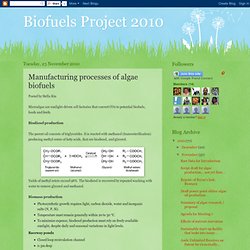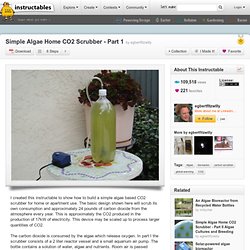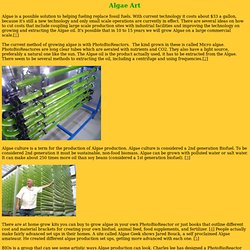

AIM Interview: NASA’s OMEGA Scientist, Dr. Jonathan Trent. Research AlgaeIndustryMagazine.com ASA scientist – the inventor, heart, and soul of the OMEGA system (Offshore Membrane Enclosures for Growing Algae) – Dr. Jonathan Trent received his PhD in biological oceanography at Scripps Institution of Oceanography. He went on to post graduate work in Europe studying the biochemistry and molecular biology of microorganisms living in geothermal hot springs, the so-called “extremophiles.” He continued his work on extremophiles at Yale Medical School and discovered a class of proteins in these unusual organisms that is closely related to a class of proteins in humans. Dr. Taking on the NASA job in 1998, he soon got involved in nanotechnology.
W2 Energy Developing Two Acres of Algae Bioreactors. Home / Scale Up / W2 Energy Developing Two Acres of Algae Bioreactors Scale Up W2 Energy’s SunFilter algae bioreactor W2 Energy Developing Two Acres of Algae Bioreactors March 16, 2012AlgaeIndustryMagazine.com The Zebrafish tube cleaning pistons. Manufacturing processes of algae biofuels. Posted by Stella Kin Microalgae are sunlight-driven cell factories that convert CO2 to potential biofuels, foods and feeds.

Biodiesel production. Google Image Result for. Benefits of our VGM™ Technology. Green Algae Strategy - Chapter 1 - What is Green Algae Strategy? - DBIWiki. From DBIWiki Solutions for sustainable, sufficient and affordable global nutritious food and high-energy biofuel may lie not in deep space, deep oceans or deep underground pools but in simple mud puddles under our feet that contain probably 50 species of the fastest growing, energy rich biomass on Earth.
Green Algae Strategy engineers solutions to resolve a set of Earth’s most intractable challenges including: An end to oil imports An end to American and global hunger An end to the need to burn fossil fuels Recapture of the carbon released in burned fossil fuels Green Algae Strategy offers green independence for America and our global neighbors who will end the need oil imports and eventually for fossil fuels. Green independence takes advantage of nature’s oldest, tiniest and yet fastest growing plant to recapture fossil carbon, to repair the Earth’s atmosphere and to produce both food and biofuel. Carbon neutral energy. Bioresource Technology - Cultivation, photobioreactor design and harvesting of microalgae for biodiesel production: A critical review. Volume 102, Issue 1, January 2011, Pages 71–81 Special Issue: Biofuels - II: Algal Biofuels and Microbial Fuel Cells Edited By Ashok Pandey, D.J.
Lee and Bruce E. Logan Abstract Microalgae have the ability to mitigate CO2 emission and produce oil with a high productivity, thereby having the potential for applications in producing the third-generation of biofuels. This lamp absorbs 150 times more CO2 than a tree. Algae CO2 Capture - All posts for Algae CO2 Capture @ Oilgae Blog.
TEDxSanJoseCA - Jonathan Trent, PhD - Can We Cultivate Energy? Biofuels from Algae Project - Brunswick Community College Center for Aquaculture & Biotechnology. Growing algae for fuel: Supplies. Algae oil part 1. Algae Biofuels and Biotech - Stephen Mayfield UC San Diego. Simple Algae Home CO2 Scrubber - Part 1. I created this instructable to show how to build a simple algae based CO2 scrubber for home or apartment use.

The basic design shown here will scrub its own consumption and approximately 24 pounds of carbon dioxide from the atmosphere every year. This is approximately the CO2 produced in the production of 17kW of electricity. This device may be scaled up to process larger quantities of CO2. The carbon dioxide is consumed by the algae which release oxygen. In part I the scrubber consists of a 2 liter reactor vessel and a small aquarium air pump.
In later parts this basic design will be expanded provide more flexibility and increased production. Maintenance is simple and straightforward as any house plant. Once or twice a year its probably not a bad idea to clean the scrubber. All that being said, let's take a quick look at the tools and materials we'll be using then we'll get started. FQSQG3MGFRWQSP2.pdf (application/pdf Object) FHG6FQ8GFRWN3IK.pdf (application/pdf Object) 58Scarsella.pdf (application/pdf Object) a519649.pdf (application/pdf Object) Article.pdf (application/pdf Object) Pdf_loader (application/pdf Object) Water Research - Rates of biogenic oxygen production in mass cultures of microalgae, absorption of atmospheric oxygen and oxygen availability for wastewater treatment.
Abstract Oxygen for the aerobic treatment of wastewater in High Rate Algal Pond (HRAP) systems arises from biogenic production by microalgae during photosynthesis and from absorption of atmospheric oxygen through the air/water interphase. The total quantity of available oxygen per m2 and day determines the permissible BOD loading rate of a HRAP. The quantity of biogenic oxygen production, has for the first time been measured in a closed bioreactor and open chemostatic cultures. Good agreement was obtained between the two methods where more than 1.92 g O2 g(dry wt) was produced by the microalgae.
This was significantly higher than oxygen yields calculated from a generalized compositional formula of algal biomass. 0000733.pdf (application/pdf Object) 10.1007/s001289900939 (application/pdf Object) 28890n.pdf (application/pdf Object) Sect3-6.pdf (application/pdf Object) Kelo_science_AustraliaAlgalOxygenSolarAerationMixingBeneficialMicrobe.pdf (application/pdf Object) 44_4_NEW ORLEANS_08-99_0851.pdf (application/pdf Object) RMB-06-Köhler-017.pdf (application/pdf Object) BioShark Technology. BioShark Techonology offers a flexible, small-scale photo-bioreactor with tubular design.

Tubular design consists of vertically stacked straight transparent tubes made out of recycled plastic, which captures solar energy required for photosynthesis. The cooling water/air mix in a tank adjacent to the algae tube stacks are added through a pump. Our algae growth system is designed to maximize outputs and simplify harvesting (see Fig.1). Our photo-bioreactors provide optimal environment for CO2 supply, water supply, maximum exposure to light, and preferred level of temperature. The photo-bioreactor has a modular design that can be expanded, increasing output without taking up much space. While the current costs in the US averages between $1.8/kg and $2/Gallon. Algae production site. Algae is a possible solution to helping fueling replace fossil fuels.

With current technology it costs about $33 a gallon, because it's still a new technology and only small scale operations are currently in effect. There are several ideas on how to cut costs that include coupling large scale production sites with industrial facilities and improving the technology on growing and extracting the Algae oil. It's possible that in 10 to 15 years we will grow Algae on a large commercial scale.[1] The current method of growing algae is with PhotoBioReactors. Gene scientist to create algae biofuel with Exxon Mobil. Gene scientist Craig Venter has announced plans to develop next-generation biofuels from algae in a $600m (£370m) partnership with oil giant Exxon Mobil.

His company, Synthetic Genomics Incorporated (SGI), will develop fuels that can be used by cars or aeroplanes without the need for any modification of their engines. Exxon Mobil will provide $600m over five years with half going to SGI. "Meeting the world's growing energy demands will require a multitude of technologies and energy sources," said Emil Jacobs, vice president of research and development at ExxonMobil.
Algae Cultivation - Tubular Photobioreactor - Oilgae - Oil from Algae. Among the proposed photobioreactors, tubular photobioreactor is one of the most suitable types for outdoor mass cultures.

Most outdoor tubular photobioreactors are usually constructed with either glass or plastic tube and their cultures are re-circulated either with pump or preferably with airlift system. They can be in form of horizontal / serpentine, vertical near horizontal, conical, inclined photobioreactor. Aeration and mixing of the cultures in tubular photobioreactors are usually done by air-pump or airlift systems.
Striving for Passivhaus Affordability. For builder Christian Corson, low numbers are good numbers.

His current project, a 1,600-sq. -ft. two-bedroom Passivhaus in Knox, Maine, has been testing well and not costing much. A few months ago, for example, with just the rough shell in place – oriented-strand board sheathing on a timber frame, all taping done, and windows installed and sealed in place – the building showed 0.545 air changes per hour at 50 Pascals pressure difference. There have been four blower-door tests since. The most recent, with construction essentially complete, Corson says, showed 0.286 ach50 – notably below the 0.6 ach50 Passivhaus requirement. But the other encouraging low number, Corson adds, is $130 – the cost per square foot, including all site work on the 10-acre lot. “This is the first step of an evolution for me to go beyond Passivhaus and do it affordably,” Corson, owner of EcoCor Design/Build, told GBA recently.
Ecofabulous. You don't have to wear a dress made out of oats or offer a cake made out of raw sprouts.

More than once, I have stopped to refuel my clean diesel hatchback and had another driver at the pumps shout at me that I'm 'using the diesel pump!! ' Yes. Yes I am. And getting unbelievable gas mileage thank you very much. Plantagon Breaks Ground on its First 'Plantscraper' Vertical Farm in Sweden! Several years ago a Swedish-American company called Plantagon unveiled plans for a series of massive skyscraper greenhouses that stood to transform urban farming in large cities.

While the spiraling vertical farms seemed too good to be true at the time, Plantagon broke ground on its very first vertical farm a few weeks ago in Linkoping, Sweden! The "Plantscraper" will grow and supply fresh vegetables while creating solutions to some of the most vexing city pollution issues. The design that was finally decided upon for the first Plantagon is no longer a sphere but an elegant tower - click through our gallery to see it.
Plantagon seems to have traded in its initial geodesic dome design for a sheer tower that both contains and showcases the plants growing inside. This prototype building will be called the International Centre of Excellence for Urban Agriculture, and it will be a place for scientists to test new technologies aimed at improving urban farming. + Plantagon. Ventilation hrv. BIOS-FIN system = Algae Biofiltration to Biofuel Building Facade System « Bios Design Collective. Posted by Charles Lee .

I have recently been sharing research with a few talented individuals over at Scottish Bioenergy. I also like some of the research I have recently seen coming from ASU from David Cardello . The Pallet Project. Biologists Engineer Algae to Make Complex Anti-Cancer ‘Designer’ Drug. Chlamydomonas reinhardtii, a green alga used widely in biology laboratories, can produce many kinds of “designer proteins.” Biologists at UC San Diego have succeeded in genetically engineering algae to produce a complex and expensive human therapeutic drug used to treat cancer. Biolamp harnesses urban air pollution for biomass fuel. Air pollution continues to plague traffic-congested urban conglomerations, compromising the health of city-dwellers. Hungarian designer Peter Horvath has designed a streetlamp that actually harnesses carbon dioxide emissions in order to produce fuel for biomass cars.
The sleek, organic design resembles a tree, branching out into two tubes at the top. One of these tubes uses a pump to draw in carbon dioxide, which is circulated into a spiral system within the green stem, along with a mixture of water and algae. The second tube exhales the resulting purified oxygen. Prime slime: S&T has big plans for underground algae - e3. The Origin of Oxygen in Earth's Atmosphere. It's hard to keep oxygen molecules around, despite the fact that it's the third-most abundant element in the universe, forged in the superhot, superdense core of stars. That's because oxygen wants to react; it can form compounds with nearly every other element on the periodic table. So how did Earth end up with an atmosphere made up of roughly 21 percent of the stuff?
Responsible Purchasing Network. According to a U.S. Environmental Protection Agency-funded project, the ingredients found in one out of every three commercial cleaning products are potentially harmful (JPPP, 1999). How much oxygen can algae produce. Active Matter Matters. In 2010, the National Science Foundation (NSF) recognized the need for novel research collaborations in the area of sustainable environmental design. For the first time in history, NSF issued a call for proposals with the requirement that architects be members of proposed project teams. The NSF Emerging Frontiers in Research and Innovation (EFRI) Science in Energy and Environmental Design (SEED) program includes a specific track focused on Engineering Sustainable Buildings. Science Buzz. If it had hands: it would be holding your life in them.
Just saying.Courtesy splorpGather ‘round, Buzzketeers, so that I might tell you all a story. Algae Growth « WeWantToLearn.net. Vertical growth/closed loop production has been developed by biofuel companies to produce algae faster and more efficiently than open pond growth. With vertical growing, algae are placed in clear plastic bags/tubes, so they can be exposed to sunlight on all sides. The extra sun exposure increases the productivity rate of the algae, which in turn increases oil production. Algae converted to crude oil in less than an hour, energy department says. The day when planes, trucks and cars are commonly revved up on pond scum may be on the near horizon thanks to a technological advance that continuously turns a stream of concentrated algae into bio-crude oil. From green goo to crude takes less than an hour. Green Light: CO2 + Water Power ‘Algae Energy’ Eco Lamp. Pet rocks and Chia pets, move over – or just sit there, as the case may be- here is a home hobby that goes beyond kitsch aesthetics to add functionality to your daily life.
Yes, now you can grow your own living, breathing, all-organic lamp with just a little love, care and the occasional fill-up with an outdoor hose or indoor kitchen faucet. Retrofitting our Skyscrapers For Food and Power. Hydrogen-Producing Skyscraper Harvests Energy From Bolts of Lightning. Algae tube cleaning system. Hydro-thermal Skyscraper in Taipei. Algae Bioreactor 2: Processing Algae For Oil Extraction. Detox Towers. 111-2.jpg (JPEG Image, 2400 × 1200 pixels) - Scaled (76%) Sustainable Green Technologies Inc. - Algae FAQ. NAMI Micro Algae Air Purification Technology.avi. An Algae Bioreactor from Recycled Water Bottles. Algae Bioreactor 1: General Operation. Algae Bioreactor 3: Oxygen Production. Science Buzz. Algae Growth « WeWantToLearn.net. Algae Biorefinery - Promise and Potential.